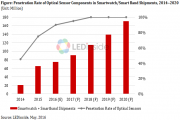 2016-05-20
2016-05-20
The combined shipments of smartwatches and smart bands will reach 7.5 million units this year, and 90% of which will be equipped with optical sensor components used for pulse rate monitoring, according to the 2016 UV LED and IR LED Application Markets Report by LEDinside, a division of TrendForce. Shipments of smartwatches and smart bands together will total 170 million units by 2020, and all of them are expected to incorporate optical sensor components. A common sensor system that measure pulse rate and blood oxygen concentration is the reflective photoplethymography (PPG) sensor. Due to opportunities in health and fitness trends, the reflective PPG sensor is gradually becoming an integral part of most wearable devices. Additionally, wearable optical sensors that can track pulse rate and other health-related data have huge potential in the home healthcare market.
Continue reading →
 2016-05-20
2016-05-20